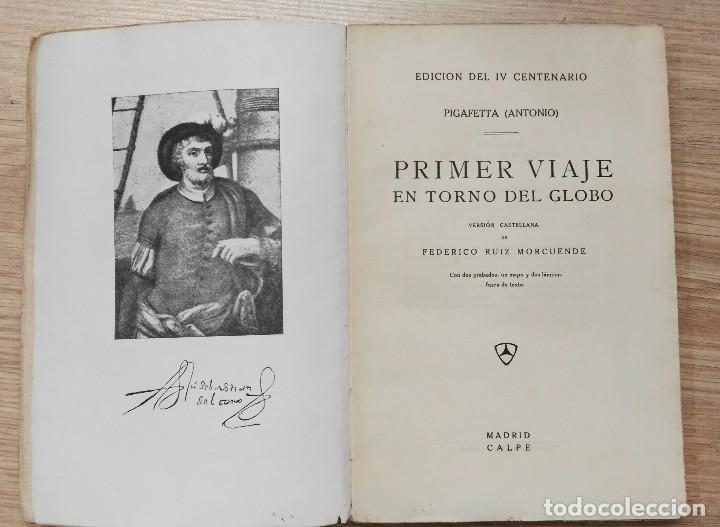

NOTE : ALL OF OUR FACSIMILES ARE MADE TO ORDER. WE ALSO ADD A THICK MULL CLOTH TO THE OUTSIDE OF THE BINDING, DRYING IN BETWEEN EACH LAYER, A TRADITIONAL WAY TO MAKE THE BINDING STIFF, STRONG, AND RESILIENT FOR GENERATIONS TO COME. THE SEWN BOOK IS BOUND WITH A STRONG ADHESIVE GLUE THAT MAKES THE BINDINGS LAST, ESPECIALLY FOR THE LARGER BOOKS. THE SIGNATURES/PAGES ARE HANDSEWN USING A LIBRARY BINDING METHOD. THE LEATHER IS ADHERED TO THE COVERS WITH GLUE AND MOLDED INTO THE SHAPE AT THE HAND OF OUR LOCAL ARTISANS. THE LEATHER IS A 4 OZ COWHIDE, FROM A SMALL SUPPLIER IN NORTH CAROLINA. The Voyage around the World manuscript in the Veneranda Biblioteca Ambrosiana is the only surviving Italian-language manuscript of Antonio Pigafettas detailed eyewitness account of the first sea voyage to circumnavigate the globe. REPRODUCTION DETAILS : OUR HARDCOVER BOOKS ARE MADE WITH REAL WOOD FOR THE INTERIOR OF THE FRONT AND BACK COVERS AS WELL AS THE SPINE. PIGAFETTA’S SURVIVING JOURNAL IS THE SOURCE FOR MUCH OF WHAT IS KNOWN ABOUT MAGELLAN AND ELCANO’S VOYAGE. OTHERS MUTINIED AND RETURNED ON THE FIRST YEAR. THESE ME COMPLETED THE FIRST CIRCUMNAVIGATION OF THE WORLD. Beinecke MS 351, the text of which is divided into 57 numbered chapters, is the most complete and most handsomely produced. 1534), an Italian gentleman from Vincenza who survived the trip.

PIGAFETTA WAS ONE OF THE 18 MEN WHO MADE THE COMPLETE TRIP, RETURNING TO SPAIN IN 1522 UNDER THE COMMAND OF JUAN SEBASTIAN ELCANO, OUT OF THE APPROXIMATELY 240 WHO SET OUT THREE YEARS EARLIER. Manuscript on parchment (fine) of A journal of Ferdinand Magellan's voyage around the world in 1522, written by Antonio Pigafetta (ca. IT IS THE FIRST RECORDED DOCUMENT CONCERNING THE LANGUAGE. DURING THIS EXPEDITION HE SERVED AS MAGELLAN'S ASSISTANT AND KEPT AN ACCURATE JOURNAL WHICH ASSISTED HIM IN TRANSLATING THE CEBUANO LANGUAGE. It was first mentioned in the 16th century in the Chronicles of Pigafetta, and is known as the oldest. HE JOINED THE EXPEDITION TO THE SPICE ISLANDS LED BY MAGELLAN UNDER THE FLAG OF THE EMPEROR CHARLES V. Antonio Pigafetta mentioned balanghai several times in his manuscripts on the Philippines. THIS IS THE FINEST OF THE FOUR SURVIVING MANUSCRIPTS PENNED BY THE FOUR WITNESSES TO THE FOREVER LOST ORIGINAL TEXTS.ĪNTONIO PIGAFETTA WAS AN ITALIAN SCHOLAR AND EXPLORER. IT IS DIVIDED INTO 57 NUMBERED CHAPTERS AND INCLUDED MAPS, NOTES AND PORTIONS ABOUT WHAT DAILY LIFE WAS ALONG THE VOYAGE. HISTORY/DESCRIPTION : THIS BEAUTIFUL MANUSCRIPT IS THE JOURNAL OF FERDINAND MAGELLAN’S VOYAGE AROUND THE WORLD IN 1522. Magellan himself was killed, on April 27, 1521, in a battle on Mactan Island, the Philippines, which Pigafetta witnessed and recounts in this work.AUTHOR: ANTONIO PIGAFETTA LANGUAGE: FRENCH DATE: 1525 PAGE #: 215 Of the approximately 240 men who set out with Magellan, Pigafetta was one of only 18 who returned to Spain. Pigafetta’s work is important not only as a source of information about the voyage itself, but also includes an early Western description of the people and languages of the Philippines. Pages from the Nancy Manuscript of Antonio Pigafettas account of Magellans voyage, Navigation Et Descouvrement De La Inde Superieure et Isles De.

It includes 23 beautifully drawn and illuminated maps. This version, in French, is from the library of Yale University, and is the most complete and handsomely produced of the four surviving manuscripts. However, an account of the voyage, written by Pigafetta between 15, survives in four manuscript versions: one in Italian and three in French. Pigafetta kept a detailed journal, the original of which is lost. The work is attributed to Antonio Pigafetta, a Venetian scholar who was born in Vincenza, Italy, around 1490 and who accompanied Magellan on the voyage. This manuscript volume, dating from around 1525, details Ferdinand Magellan's voyage around the world in 1519-22.


 0 kommentar(er)
0 kommentar(er)
